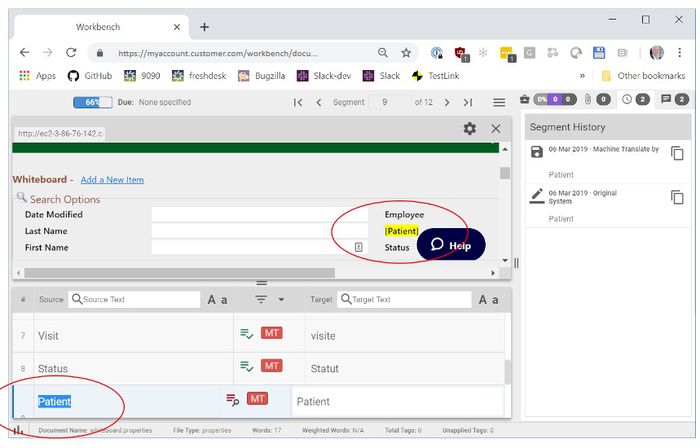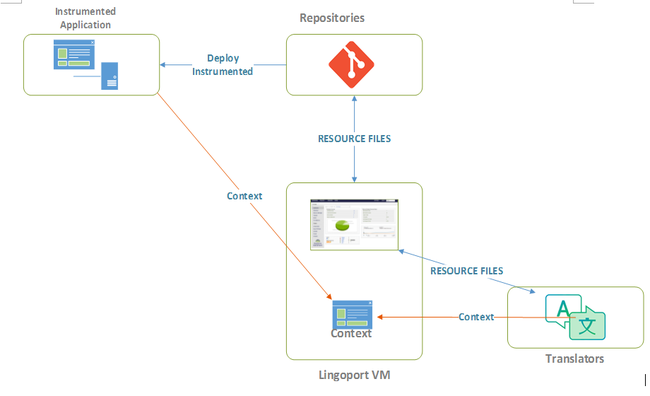Difference between revisions of "About InContext Translation"
(→System Overview) |
|||
| (22 intermediate revisions by 3 users not shown) | |||
| Line 1: | Line 1: | ||
| + | Translators use InContext Translation, a Lingoport product which passes the context of a Web application along with the resource to be translated. Translation Management Systems (TMSs) can then show the context within the translation workbench, either via a note, a comment, a clickable link, or a view from within their computer aided translation (CAT) tools. |
||
| − | = High Level Goals = |
||
| − | * The Lingoport InContext Translation allows for a better-quality translation earlier with possibly reduced need for downstream Linguistic QA. Lingoport is not a translation company or a TMS vendor. The aim of In Context Translation is to provide TMS with the ability to associate segments with context. |
||
| + | [[File:InContextTranslation.jpg|700px]] |
||
| + | |||
| + | In this example, the string to be translated is "Patient". The translator can see where this string is being used in the application since it is highlighted and can make the appropriate translation. |
||
| + | |||
| + | = Goals = |
||
| + | * The Lingoport InContext Translation product allows for a better-quality translation earlier with possibly reduced need for downstream Linguistic QA. Lingoport is not a translation company or a TMS (Translation Management System) vendor. The aim of InContext Translation is to provide the TMS with the ability to associate segments with context during the translation process. |
||
= Benefits = |
= Benefits = |
||
| + | * The translation team uses the TMS, tools, products, and processes of their choice. |
||
| − | * |
||
| + | * Agile: short translation bursts come from different projects and applications: Context really helps translation. |
||
| + | * The translation context can be invoked by a simple URL . |
||
| + | * No software developer involvement. |
||
| + | * Non-intrusive |
||
= System Overview = |
= System Overview = |
||
| Line 11: | Line 20: | ||
For an on-boarded repository, the happy path looks like: |
For an on-boarded repository, the happy path looks like: |
||
| − | * The repositories contain base resource files created by developers and files translated by LSP. |
+ | * The repositories contain base resource files created by developers and files translated by the LSP (localization service provider). |
| − | * |
+ | * Localyzer analyzes the resource files and '''instruments''' both base and target files. |
| − | * |
+ | * Localyzer pushes the '''instrumented''' files to the repository |
* An instrumented build gets deployed |
* An instrumented build gets deployed |
||
| − | * With each navigation to a new page on the instrumented deployment, InContext Capture |
+ | * With each navigation to a new page on the '''instrumented''' deployment, the '''InContext Capture''' Chrome extension saves the context back to the Lingoport VM. Localyzer then sends the association between the context and each of the base resources to the TMS. |
| − | * When files are sent to translation, each segment may have a context |
+ | * When files are sent to translation, each segment may have a context and a URL, a [[Terms_and_Definitions#Decorated|decoration]], pointing back to a Lingoport '''InContext Server''' that stores the context. |
| + | |||
| + | = License = |
||
| + | [[InContext Translation License]] |
||
Latest revision as of 20:57, 26 April 2022
Translators use InContext Translation, a Lingoport product which passes the context of a Web application along with the resource to be translated. Translation Management Systems (TMSs) can then show the context within the translation workbench, either via a note, a comment, a clickable link, or a view from within their computer aided translation (CAT) tools.
In this example, the string to be translated is "Patient". The translator can see where this string is being used in the application since it is highlighted and can make the appropriate translation.
Contents
Goals
- The Lingoport InContext Translation product allows for a better-quality translation earlier with possibly reduced need for downstream Linguistic QA. Lingoport is not a translation company or a TMS (Translation Management System) vendor. The aim of InContext Translation is to provide the TMS with the ability to associate segments with context during the translation process.
Benefits
- The translation team uses the TMS, tools, products, and processes of their choice.
- Agile: short translation bursts come from different projects and applications: Context really helps translation.
- The translation context can be invoked by a simple URL .
- No software developer involvement.
- Non-intrusive
System Overview
For an on-boarded repository, the happy path looks like:
- The repositories contain base resource files created by developers and files translated by the LSP (localization service provider).
- Localyzer analyzes the resource files and instruments both base and target files.
- Localyzer pushes the instrumented files to the repository
- An instrumented build gets deployed
- With each navigation to a new page on the instrumented deployment, the InContext Capture Chrome extension saves the context back to the Lingoport VM. Localyzer then sends the association between the context and each of the base resources to the TMS.
- When files are sent to translation, each segment may have a context and a URL, a decoration, pointing back to a Lingoport InContext Server that stores the context.

